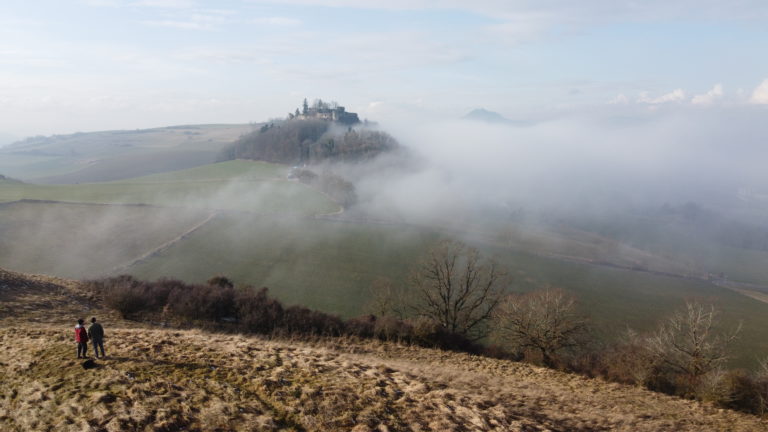Alan Watts on Ups and Downs
Whether we find ourselves in a time marked by setbacks, or a period in our lives when we are doing well, one should always be aware that ups and downs go hand in hand. This is exactly the topic Alan Watts covered in his lecture on the fact that ups and downs go together.
In his speech about highs and lows, Alan Watts wants to show us that you can't have one without the other. Every high is followed by a low and vice versa. Just as a saw that has only peaks, with no valleys between them, cannot cut, neither can we live on a permanent high. We must see life as a whole, with light and shadow sides.
Here is the video with Alan Watt's speech about ups and downs. After the video, I'll go into more detail about what he meant (if you don't know English, just skip the video):
Personally, I like this statement by Alan Watts so much that I designed it as a symbol and had it tattooed on my forearm in Bangkok (that's right: it's the tattoo you see at the top of this post).
But enough of digressions, let's now have a look at what Alan Watts said and meant. For the sake of understanding, the translation is not exact. However, I have taken great pains to translate it objectively into German as well as I could without changing the meaning.
Highs and lows
The problem is that we have one-sided psyches... have. That's why in life we usually notice only the peaks, or high points. We hardly notice when it is at a low point. In the conventional sense, it is the high points that count.
Let's take a saw as an example. What seems important to us are the tips of the teeth, they seem to be responsible for cutting. We hardly notice the valleys between the teeth and we don't realize that you can't have tips without depressions.
So the saw wouldn't cut either if it didn't have both peaks and V-shaped valleys. But we ignore it, we don't notice the valleys as much as the mountains.

Valleys point down - mountains point up.
We prefer things that point upwards .
Because up is good and down is bad.
Joking aside; we do not praise the peaks because they are high, and do not blame the valleys for being low. It is, however, that we ignore the valley aspect of things.
All knowledge begins with not seeing the valley aspect separately from the mountain aspect.
We pay much more attention to the summit aspect, as it catches our attention more.
Somehow we often completely blank out the valley aspect. But since we seem to be able to enjoy only the peaks, this actually prevents much pleasure and makes us quite uncomfortable. Because deep down we know that every peak is followed by a valley.
The valley of the shadow and death
We are in permanent fear because we are not used to looking at the valleys. We are not used to living with them. They represent to us a strange and threatening unknown.
Possibly we are afraid that the principle of the valley will win and the peaks will be overwhelmed forever. Perhaps death is stronger than life. Life always corresponds to effort. Death is something you can glide into effortlessly. Possibly nothingness will defeat existence in the end, wouldn't that be terrible?

So we try to resist change in life, blinded by the fact that change is life.
We ignore the fact that emptiness is always the opposite of being, without exception. Most people are afraid of emptiness. And therefore they ignore it and think emptiness is nothing.
But: Emptiness and existence are two ways of talking about the same thing.
Emptiness, existence.
You don't find emptiness without existence and you don't find existence without emptiness.
If you say there is a universe in which there is nothing but emptiness, then the emptiness is between what?
Existence is always related to emptiness.
Just as the front, goes hand in hand with the back.
Our polarizing mind, however, ignores emptiness. It assumes it is space, or existence, that does all the work, that it is the only thing that constitutes reality.
The conscious attention ignores intervals

Let's take a look at music:
What you really hear when you listen to a melody is the interval of one note and the next.
Like the steps of a scale. It is the interval that is important. Without distance no melody.
In the same sense as the intervals between the leaves of this autumn and the leaves of last autumn,
of this generation of people and that generation of people. So what lies in between is just as important as the events themselves.
The interval is just as important - in some ways even more important - than what lies between it. In fact, they are exactly equally important. I sometimes just say that the interval is more important because we underemphasize it. So I overemphasize it as a correction.
The emptiness, the night, the death, the darkness, not being there is an essential component in order to To be there.
You can't have one without the other.
Just as the saw cannot cut without the indentations between its tooth tips, you cannot have life without depths and heights.
With this comparison, Alan Watts has pointed out an important fact that very rarely receives attention, especially here in the Western world. And that is a pity. If we realize that ups and downs, good and bad are part of life, we will experience a much higher degree of relaxation if things don't go as well as we would like.
And that brings us some of the balance that is in these things.
Did you like this article? You can let us inform you about new articles:







